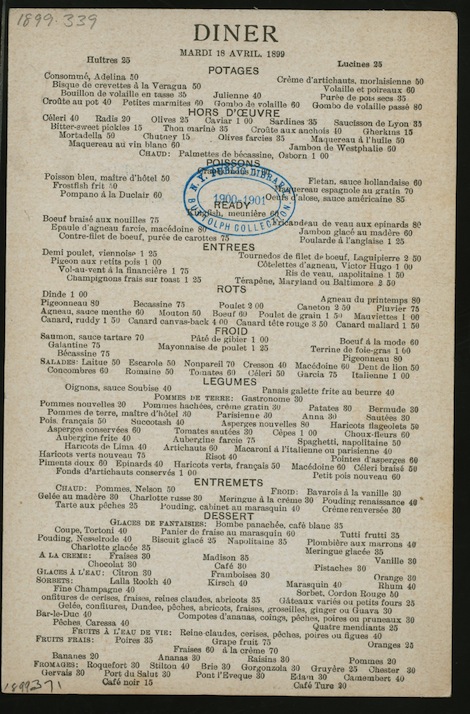You folks who enjoy voluminous old menus might enjoy this one from Jack and Marion’s deli in Brookline, Mass, circa 1950s I think. I used to dine there once in a while.
Behold the legendary 11-page menu from Shopsin’s.
Actually the general eating chicken tended to be smaller - around a kilo/2.2 pounds to about 1.3 kilo/3 pounds, basically what we now consider bantams. They used capons [gelded chickens] if they wanted something in the 4-5 pound/1.8 // 2.2 kilo range [which is roughly what we consider normal size now - our current capons can be up to 9 pounds/4 kilo.] I have an 8 pound capon in the freeze right now.
So, half a bantam is something we could consider more like the weight of a current quarter chicken, or a whole bone in skin on chicken breast or leg/thigh bone in skin on quarter.
Still, a bit much for an appetizer. I could see a breast quarter minus the wing as a decent small serving. As an entree I would consider an attereaux [cute little skewers of food, frequently served stuck into decorative bread loaves that you take the skewer and shove the food bits off onto a small plate and eat them.]
I’ve been looking for this one! I saw it years ago but had forgotten the name, and “NYC restaurant with big menu” wasn’t leading me anywhere on Google.
I love the “extra special” sandwich with the note that you’re definitely getting overcharged for it.
I learned from Chef Ramsay that menus with dozens of choices don’t work. He constantly tells restaurants to pick what they do best and put on the menu.
I would approach the Delmonico’s menu like a cafeteria menu. Pick a couple things that I want and don’t worry about courses.
I’d fail the social status test. ![]()
1834 seems a little early for “hamburger steak” to be on the menu. According to Wikipedia, the oldest known English use of the term is a Delmonico’s menu from 1873 that offered “hamburg steak” for ten cents.
I can’t vouch for it, but here’s the source.
I’m guessing that “pudding” is some sort of savory dish and not a dessert?
Apparently it’s from an unrelated Delmonico’s in the 1880s.
Tuxedo is “Semi-Formal”. “Informal” means a daytime business suit and tie. I think it’s called a “lounge suit” in Britain. Anything less than suit-and-tie is “Casual”.
Formal:
Daytime: Morning Dress, aka formal day dress.
Nighttime: Evening Dress, aka white tie and tails, aka the penguin suit.
Semi Formal:
Daytime: Stroller, aka black lounge suit, aka Stresemann.
Nighttime: Black Tie, aka dinner jacket, aka Tuxedo jacket.
In addition, Delmonico’s was never at that address. From 1827-1835, they were at 23 and 25 William Street. They were an elegant French restaurant, not the sort of place one would expect to find crullers or pork and beans. Indeed, as I understand it the earliest menus were actually written in French.
The menu I posted in the OP apparently had an identical menu in French on its backside;
(Unhelpfully, Garcia salad is apparently named the same thing in French, so I guess I’ll never know what sort of mayo-coated greens it consisted of.)
494 Pearl St. is now a courtyard adjacent to the SDNY federal courthouse, while 23-25 William St is now part of a deli.
With such a wide variety of foods, like squab, pigeon, duck, lamb, and chicken, how did they keep things fresh: ice chests/cellars? Or were items butchered close to when needed? Did they always have all the advertised ingredients available, or were people told specific things would be unavailable? There must be accounts of someone ordering menu items that were unavailable.
There were still actual farms in Manhattan at the time, so I imagine most of their stock was procured locally.
And you’d think the chef could always step outside to grab a couple of fresh pigeons.
Bird hunting at the time was a bit more industrialized than that. Punt guns were still legal back then.
Also, in a 19th-century fancy restaurant a knowledgeable patron would expect to be able to consult the waiter, or even the restaurateur himself, to optimize his selections on that particular day.
Not sure if this helps narrow it down, but a google search shows that Garcia salad was served in the school cafeteria in Craon, Mayenne on January 22, 2019:
https://www.eterritoire.fr/detail/sorties-ouest/restaurant-scolaire/3144945520/pays-de-la-loire,mayenne,craon(53400)
so Garcia salad lives on ![]()
Here is one recipe:
Cut celery, apples, and fresh tomatoes in thin strips about two inches long, serve on lettuce leaves with French dressing. A slice of truffle on the top adds both to the appearance and flavor.
(from The Good Housekeeping Hostess manual, 1904)


